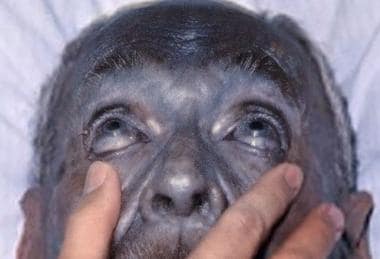Practice Essentials
Argyria results from prolonged contact with or ingestion of silver salts. Argyria is characterized by gray to gray-black staining of the skin and mucous membranes produced by silver deposition. Silver may be deposited in the skin either from industrial exposure or as a result of medications containing silver salts. See the image below.
 A 92-year-old asymptomatic white man with generalized argyria. For many years, this man had used nose drops containing silver. His skin biopsy showed silver deposits in the dermis, confirming the diagnosis of argyria. © Dec 3, 2008 Herbert L. Fred, MD; Hendrik A. van Dijk. Textbook content produced by Herbert L. Fred, MD; Hendrik A. van Dijk is licensed under a Creative Commons Attribution License 2.0 license.
A 92-year-old asymptomatic white man with generalized argyria. For many years, this man had used nose drops containing silver. His skin biopsy showed silver deposits in the dermis, confirming the diagnosis of argyria. © Dec 3, 2008 Herbert L. Fred, MD; Hendrik A. van Dijk. Textbook content produced by Herbert L. Fred, MD; Hendrik A. van Dijk is licensed under a Creative Commons Attribution License 2.0 license.
See Poisoning Clues on the Skin: 8 Cases, a Critical Images slideshow, to help diagnose patients based on their dermatologic presentations.
The most common cause of argyria is mechanical impregnation of the skin by small silver particles in workers involved in silver mining, silver refining, silverware and metal alloy manufacturing, metallic films on glass and china, electroplating solutions, and photographic processing. Colloidal silver dietary supplements are marketed widely for cancer, AIDS, diabetes mellitus, and herpetic infections. [1, 2, 3] Cases have followed the prolonged use of silver salts for the irrigation of urethral or nasal mucous membranes, in eye drops, wound dressing, and the excessive use of an oral smoking remedy containing silver acetate. [4, 5]
Argyria has also been attributed to surgical and dental procedures such as silver amalgam-tattooing, silver sutures used in abdominal surgery, and silver-coated large prostheses. [6] Blue macules have appeared at sites of acupuncture needles and silver earring sites. [7, 8] Great individual variability exists in the length of exposure and total dose needed to result in argyria.
Prognosis
A permanent and irreversible metallic tinge occurs in the skin of patients with argyria.
Diagnosis
The diagnosis of argyria is established by skin biopsy with formaldehyde-fixed paraffin-embedded sections stained with hematoxylin-eosin.
Treatment
See Treatment and Medication.
Pathophysiology
Localized argyria occurs in the conjunctiva or oral mucous membrane after long-term topical treatment with silver salt solutions or short-contact acupuncture.
Universal argyria can develop after long-term systemic treatment with drugs that contain silver salts. This used to occur in patients who had taken silver protein suspension for chronic gastritis or gastric ulcer or as nose drops. [9] Argyria also happens as an occupational disease in workers who prepare artificial pearls or who are employed in the cutting and polishing of silver (absorption of silver dust).
The normal human body contains approximately 1 mg of silver; the smallest amount of silver reported to produce generalized argyria in humans ranges from 4-5 g to 20-40 g. Silver at 50-500 mg/kg body weight is the lethal toxic dose in humans.
Bianchi et al report a possible genetic predisposition for argyria. [10]
Etiology
Although pigmentary changes occur primarily in sun-exposed sites, granules are evenly deposited throughout all skin. Differing theories exist as to why the blue-gray pigmentation is restricted to sun-exposed sites. Some believe that silver compounds complexed with proteins in the skin are reduced to elemental silver by light, similar to the process of photo imaging. [11] Others contend that silver plus light stimulates melanogenesis, which results in the blue-gray color.
Epidemiology
Argyria has become a rare dermatosis, mainly because of the avoidance of silver-containing compounds as medicinals and a decrease in occupational exposure in the silver industry. Exposure to silver was common in the early part of this century. The famous Blue Man, a member of the Barnum and Bailey Circus sideshow, had a classic case of argyria.
-
A 92-year-old asymptomatic white man with generalized argyria. For many years, this man had used nose drops containing silver. His skin biopsy showed silver deposits in the dermis, confirming the diagnosis of argyria. © Dec 3, 2008 Herbert L. Fred, MD; Hendrik A. van Dijk. Textbook content produced by Herbert L. Fred, MD; Hendrik A. van Dijk is licensed under a Creative Commons Attribution License 2.0 license.





